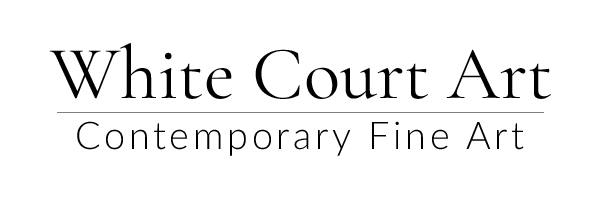The Phenomenon that is Sax Berlin
As a gallery White Court Art constantly searches for the very best in contemporary British art and artists. In a small provincial auction several years ago we discovered a fascinating painting the like of which we had never encountered and knew we had to have! After some research we finally found the artist who had painted this remarkable piece – Sax Berlin. Thus began a journey of discovery and delight for us all.
Living in Manhattan, Sax was a contemporary of Basquiat and Keith Haring but developed his art in isolation. He had no backing or a real studio, instead creating his pieces in the hallway of his apartment and supporting his family by working as a bicycle courier on the busy streets of New York City. He still works while listening to cassette recordings he made during those years; colourful backdrops of China Town, Little Italy or just his journey through the city.
As he says he “found established techniques and values pedestrian & outmoded. Unable to express the fluidity of my vision”. Thus over a 3 decade period he has invented several techniques to suit his temperament. Sax has developed 11 unique styles and 6 techniques, 5 of which are innovations seen nowhere else. Nothing prepares one for the impact of his paintings, the current Flowers for Athena series is a case in point and created from an encounter many years ago at an ancient Greek temple. Each technique used creates a different form of his art; whether it’s his spiritual Buddha series, the jazz inspired Manhattan project, the coquettish Zizi of his School of Paris works, Neo-Nouveau or Pearl series all are imbued with his mastery.
Berlin is the antitheses of modern art perception today; he individually creates every piece from the outset to the finished work, seeking to put the integrity back into art and counter the current trend of “dead art”. Skulls and dead animals have no place in his pantheon; his nuanced handling of materials and oft forgotten techniques return art to a place of integrity. His philosophy is simple, “the canvas, the texture, the brush, the pigment and the hand all know what they are doing and all I can do is step aside, officiate and marvel at the phenomena”.
Art now being created is improved by on-line galleries like White Court Art; artists no longer feel impelled to “sell out” in order to get exhibitions. Berlin is in the vanguard of this movement, enabling us to employ our visual vocabulary to translate our visual impressions. As he states “these are my explorations in the metaphysical pigment of space”. This new metier enables Berlin to concentrate on his own pieces as he needs to create them, without the dictat of convention or what he sees as the tyranny of galleries & the art establishment in general. The chord of freedom and lack of constraint that Berlin imbues his art with is becoming ever more resonant with art collectors. He has many dedicated collectors in the United States, some of whom are important national figures in art & museum circles.
A highly spiritual man, Berlin feels that his astronomical chart has much to do with his prodigious creativity. At his birth the stars aligned with all but 1 in the House of Creativity, a most rare phenomenon. Nowhere is his creativity & spirituality showcased better than in the “Flowers for Athena” project. Here he pays his tribute to ancient Greece. Many years ago Berlin was at the Temple in Delphi when a message came to him saying that this was a sacred place & he shouldn’t be there. Now, decades later, he has created these large and beautiful paintings as his homage and apology.
In Georgia O’Keeffes words “to create ones own world takes courage”; an epithet that could be written directly for Berlin. He lives a life in tune with his surroundings; spending time in the studio but living close to the earth in a small caravan in touch with the elements and forces of nature. He has no car, travelling only on his idiosyncratic bicycle between the places that inspire him. Sometimes a Japanese tea house, or a mountain top in Nepal, or an ancient site in Greece, or a busy Manhattan street; all have played their part in making Berlin the unique artist he is today.
Berlin firmly believes that “Pablo Picasso came and showed us how to work, but nobody listened – until now”. Comparisons have been made with Picasso and these two artists are similar in their ethos, Picasso stating that “to draw you must close your eyes and sing” and Berlin believing that he’s the instrument through which his stunning paintings are created. In this there’s also a similarity with that much troubled genius Vincent van Gogh whose “emotions were so strong that I work without knowing it”.
As with all geniuses the juice of creativity flows strong and deep in Berlin. There is no-one painting with his integrity and techniques; a true Master Artist, he is a Revivalist and outlet for classic modern painting. He is teaching us via his extraordinary paintings the meaning of artistry. The Chemistry of Colour typifies Berlins approach to his work; all his pigments are hand ground, incorporating the shades used by the Master Artists of old; cadmium, vermillion, cobalt, Caput Mortem. These supersaturated colours are blended with crushed marble or volcanic glass, or earth from Mount Vesuvius in an evolution of traditional colour paths. We are all familiar with these tints, they form part of our collective visual memory and deserve their place. Berlin firmly believes that there is a connection between Picasso & his place in 20th century art and the place that he is carving in 21st century art.
Creativity takes courage and self-belief, art is not what you see, but what you make others see and Berlins works are resonant with this ethos of classical grace and geometric order. Particularly with his current series of “Flowers for Athena“, a deeply moving series of works allowing Berlin to freely express his vision and to make his art available to a worldwide audience.
The highest technical skills become an unconscious act as Sax Berlin surges through his chosen medium, disturbing and delighting our senses and demonstrating what is possible in Modern Art. Given the freedom to work his magic we know that there’s so much more to come from this phenomenal and prodigious talent. An exciting prospect indeed!

